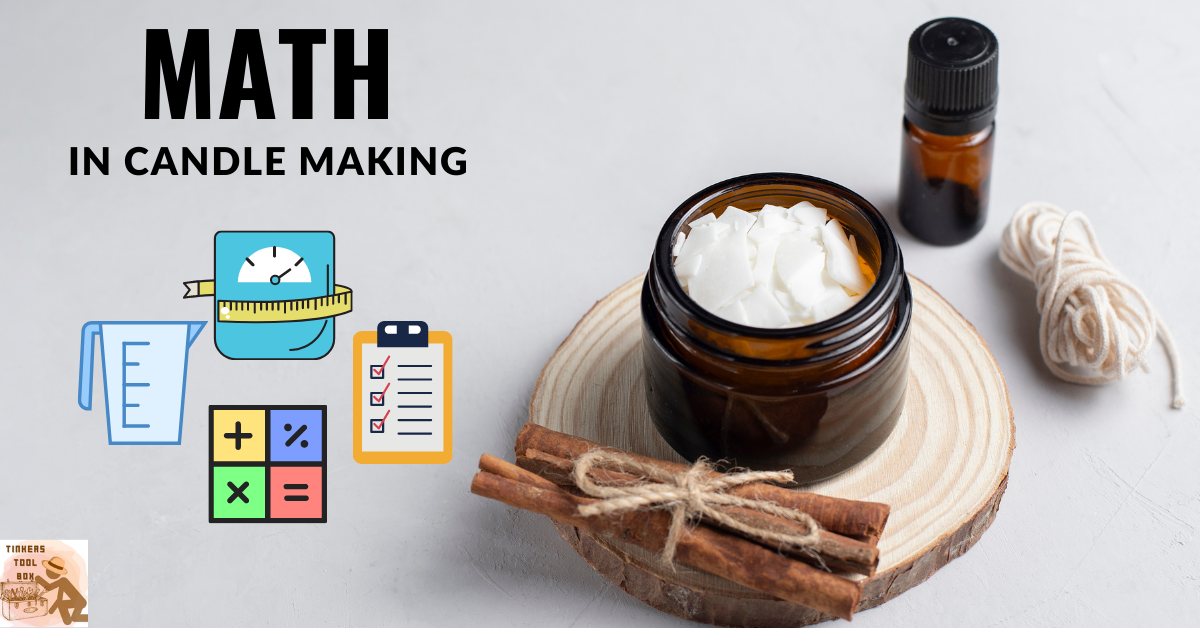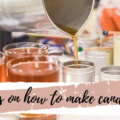Candle making is not as easy as pouring all ingredients into a jar and producing perfectly burning candles. It requires a lot of measurements and calculations that determine the quantities you’ll need for each ingredient. These formulas also ensure that each candle burns as expected without putting excessive or minimal amounts than intended.
In candle making, ingredients should be measured by weight. Solving for the total weight of candle wax, the fragrance loads, and the percentage of color dyes must be anchored into specific formulas to ensure that the candles are produced with the appropriate amount of ingredients.
This article talks about all the formulas and calculations you need to know in candle making, from the ratio of wax to fragrances and other ingredients to the burn rate of each produced candle. I will also emphasize why math is important in candle making and why each formula is needed in producing well-burning candles. You can also find some sample calculations to guide you in your candle making journey.
- Amount of Wax Needed for Candles
- The Fragrance Loads and the Amount of Fragrances A Candle Needs
- Determining the Burn Time of a Candle
- Color Dye Percentages for Each Candle
- Conclusion
Amount of Wax Needed for Candles
Measuring the amount of wax needed for a candle is not as simple as pouring the wax into the container and expecting it to be the same amount when melted. Furthermore, you cannot trust that the size of the container would be a perfect reference for your candle, as candle wax does not have the same volume as water.
Water Weight is Different from Candle Wax Weight
In candle making, the medium used in measurement is by weight and not volume. That is because most ingredients in candle making reduce in volume when incorporated into the melted wax. Hence, if you do not calculate the correct portions of each ingredient, your candle would contain either excessive or minimal amounts, which would not burn well.
The idea that a 16 ounces jar containing water would capture the same amount of candle wax is a misconception. Water is denser than candle wax, taking up more space than water does.
Think of a jar filled with marbles representing water, heavy but not big. In contrast, candle waxes would most likely represent cotton balls, lighter in weight but taking up more space. Hence, when you put the same amount of water and candle wax into two same-sized containers, the wax would look more than the water.
The Role of Water in Measuring Wax Weight
Water and wax may differ, but water is one good material to use as a reference to measure the exact amount o wax a container can handle. A concept of specific gravity links the two with each other and why one is heavier or lighter than the other.
On average, candle waxes have about 86% density, which means it has a specific gravity of 0.86, while water has 1.0. Hence, water is denser than candle wax. If, for example, a container holds 3.5 ounces of water, about three ounces of melted wax could occupy the same space.
You see here how water could be a reference in measuring how much wax a candle container could hold.
Computing for the Amount of Wax Needed for a Specific Container Size
Computing for the wax weight follows specific computations to ensure that your created candle would fit into the given space. Here are the steps you can follow.
Determine the Total Fragrance Load
The first step is determining how much fragrance you want for your candles. These ranges range from 3% to 12%, depending on your preference. The most fragrance a candle wax can handle is 12%, having 10% as the safest net. A 6% fragrance load would be perfect for a subtle scent.
We’ll take 6% as our fragrance load (F) in this example.
Measure the Weight of Container When Empty and Filled with Water
The next step is to prepare your desired candle container. You’ll be ding two measurements here. First, you must weigh the empty container and record it in ounces or grams (not liquid ounces). Then fill the container with water up to your candle’s desired height. Weigh it in and record using the same unit.
For example:
Weight of empty container = 70 grams
When filled with water = 170 grams
Water weight = 170 g – 70 g = 100 grams
Compute for the Total Weight of the Container
The total weight (TW) refers to the final weight of the candle wax, including the fragrances that go into the container. Multiply the water weight to the wax’s specific gravity (0.86).
TW= 100 x 0.86
TW = 86 grams
Calculate the Wax Weight (W)
This part tells us the exact amount of wax a container can hold. Calculate the wax weight by dividing the total weight of the container (TW) by the sum of 1 (water’s specific gravity) and the fragrance load (F).
Convert the fragrance percentage (6%) into decimal.
F= 6 / 100
F= 0.06
Compute the total wax weight.
W= TW / (1+F)
W= 86 / (1+0.06)
W= 86 / 1.06
W= 81 grams
The total wax weight for each container is 81 grams.
Determine the Total Amount of Wax Needed
Now that we have come up with the amount of wax needed for a specific container, we will multiply it by the number of candles you will produce or the number of containers you’ll use in making the candles.
For example, you will make six candles:
Total Amount of Wax = Wax Weight x Number of Containers
Total Amount of Wax = 81g x 6
Total Amount of Wax = 486 g
You’ll need 486 grams of candle wax to produce six candles with a fragrance load of six percent.
Custom Wax Blends Ratio
If you plan to create wax blends or combine multiple waxes, you need first to determine the terms of percentage for each wax. Then, multiply the percentage by the total wax weight computed above to get the portion of each wax.
For example, your total wax weight is 496 grams. You intend to blend four different waxes with the following percentages:
Paraffin wax = 40 %
Soy wax = 25 %
Soy wax 2 = 15 %
Coconut wax = 20 %
Convert the percentages into decimal numbers by dividing them by 100.
Paraffin wax = 40 / 100 = 0.4
Soy wax = 25 / 100 = 0.25
Soy wax 2 = 15 / 100 = 0.15
Coconut wax = 20 / 100 = 0.2
Multiply the percentages to the total wax weight to get the portions of each wax.
Paraffin wax = 0.4 x 486 = 194.4
Soy wax = 0.25 x 486 = 121.5
Soy wax 2 = 0.15 x 486 = 72.9
Coconut wax = 0.2 x 486 = 97.2
When added, the total amount of the waxes should equal the total wax weight of 486 grams.
The Fragrance Loads and the Amount of Fragrances A Candle Needs
Fragrance oils are the heart of scented candles. Your candles would not be as fresh-smelling as you love without them. It requires precise measurements and computations to ensure that only the proper amount of fragrance is incorporated.
Measuring Fragrance Oils by Weight and Not Volume
We’ve mentioned before how important it is to measure candle making ingredients by weight and not volume. As these ingredients are melted and changed into liquid form, their volume may not be the same value as their weight. Furthermore, manufacturers have long used weight as the unit of measurement in candle waxes, fragrances, and color dyes.
Sticking to one unit of measurement would ensure that only the appropriate amount of ingredients are incorporated into your candles. Also, note that putting too much or too little fragrance in candles would result in a weak scent throw, so following the required fragrance loads for each candle wax is essential.
How Much Fragrance Oils Do Candles Need
Now that we’ve calculated the amount of wax needed for a candle container, we can measure the fragrance oils relative to this size. Fragrance loads for each candle wax are measured by percentages.
Often, can find this on the wax’s packaging. If there is no indicated fragrance load for your purchased wax, it is safe to assume that a five to six percent fragrance load will do (considering that five percent is the minimum fragrance and twelve percent is the maximum). Here is a simple breakdown of steps you can follow to measure exact amounts of scents.
Measure the Wax in Ounces or Grams
In this step, we measure the amount of wax and convert them into ounces or grams for easier computations. In our example above, we’ll use the unit grams for our wax and fragrances to ensure that the output measurement is correct.
Determine the Fragrance Load
Be mindful of following the prescribed fragrance load for each candle wax. You may see the percentage required for each candle on the wax’s packaging or use the minimum load of three to twelve percent.
For beginner candle makers, it is safer to choose a lower concentration of fragrance loads if you can’t find the specific ones on the packaging. The maximum twelve percent load is often too much for candle waxes, making them not burn well and lose their strong scent throw.
Compute for the Weight of the Fragrance Oils
Now that we have completed all the values, it is time to compute. We’’’ use the following legends in your computation:
W = wax weight (in grams or ounces)
F = fragrance load (in percent)
FW = fragrance oil weight
To solve the fragrance oil weight, just divide the fragrance load in percent by 100 to convert it into decimal. Then, multiply the quotient by the total wax weight to get the final fragrance weight. You can use this simple formula.
FW = (F / 100) x W
Now let us solve for the fragrance weight of our wax that we have computed above. Here are the values:
W = 486 grams (for six pieces of candles)
F = 6 %
Compute the total fragrance oil weight needed for six candles with 486 grams and a fragrance load of 6 %.
FW = (F / 100) x W
FW = (6 / 100) X W
FW = 0.06 x 486 g
FW = 29.16 g
The total fragrance oil weight needed for six candles weighing 486 grams is 29.16 grams or 4.86 grams per candle.
The total blend weight is 515.16 grams or 85.85 per candle.
Wax = 486 grams (81 grams each)
Fragrance Oil = 29.16 (4.86 grams each)
Note: You can follow the same formula whether you measure your ingredients in grams, ounces, or pounds. Just remember not to use volume as a unit of measurement.
Determining the Burn Time of a Candle
Candle burn translates to the exact amount of time for candles to fully burn. Burn time varies on each candle and is affected by several factors such as the wax used, the type of wick, and the candle’s location. While burn time does not exactly affect the candle performance, it is also important to know how long these candles burn to estimate when would need to replace them with a new one.
Here are the steps in computing for the candle burn time.
Weigh the Candle and Subtract the Container’s Weight
Compute the candle burn time by weighing the unburned and newly produced candle on a scale. Then, subtract the weight of the container (if it is a container candle) to get the original weight of the candle.
For example, your candle weighs 100 grams, and the container is 20 grams.
OW = WW – CW
Where:
OW (original weight)
WW (wax weight)
CW (container weight)
Solve for the original weight of the candle.
OW = WW – CW
OW = 100 g – 20 g
OW = 80 g
The original weight of the candle is 80 grams.
Light the Candle and Allow it To Burn
Following the safe candle burning practices, light the candle and let it burn for four continuous hours. Do not interrupt this burn time, as the first burn determines the overall performance of your candle. Furthermore, place the candle in an area away from the draft to avoid having a shaky flame that would result in uneven candle burn and shape.
Measure the Post-Burn Weight
After four continuous hours, blow out the candle and let it cool. Weigh the candle again, subtracting the container weight to come up with the post-burn weight. Record this weight to calculate the total hourly burn rate.
The Total Hourly Burn Rate
Compute the total hourly burn rate by subtracting the post-burn weight from the original weight of the candle. Divide the difference into the number of hours burned, which is the candle’s hourly burn rate.
Let us take, for example, our values above. Suppose, after burning, the measured post-burn weight of the candle is 40 grams.
HB = (OW – PW) / H
Where:
HB = hourly burn rate
OW = original weight
H = total hours burned
Compute for the total hourly burn.
HB = (OW – PW) / H
HB = (80 g – 40 g ) / H
HB = 40 g / 4 hrs
HB = 10 g per hour
The total hourly burn is 10 grams per hour.
To calculate the approximate burn time:
Approximate Burn Time = Original weight / Hourly burn rate
Approximate Burn Time = 80 g / 10 g per hour
Approximate Burn Time = 8 hours
The candle would approximately burn and last for 8 hours.
Color Dye Percentages for Each Candle
In using color dyes for candles, the percentages of each color vary depending on the tone and strength of the color you want for your candles. Medium-shade colors like red, yellow, and blue would need about 0.05 % dye to color a pound of wax. That is around seven to eight drops of liquid dye per pound of wax used.
For example, you will produce a batch of candles with ten pounds of wax weight. To determine how much color dye you will add, multiply the percentage by wax.
Convert the percentage to a decimal number by dividing it by 100.
P= 0.05 / 100 = 0.0005
Compute the color percentage.
CP (color percentage) = WW (wax weight) x P (percentage)
CP = 10 pounds x 0.0005 %
CP = 0.005 pounds
Since a 0.005 pound of liquid dye is hard to measure using a scale, you can convert it into ounces or grams for a smaller measurement scale. In this case, we’ll use grams as our reference.
Convert the color percentage of 0.0005 pounds to grams. The weight in grams equals pounds multiplied by 454 (the conversion unit for pounds to grams).
CP = 0.005 x 454 grams
CP = 2.27 grams
You’ll need to add 2.27 grams of color dye to your 10 pounds of candle wax.
Now that we have covered all the measurements in making candles, another math that we need to compute is the cost of all the candle making tools and ingredients. Here is an article to keep you guided on the breakdown of the expenses of making candles.
Conclusion
It is quite evident that you’ve been smarter after going through this article. Indeed, exact measurements through mathematical calculations are essential in candle making. These formulas will guide you well in incorporating specific amounts of ingredients and producing perfect candles. You can rest assured that no ingredients are wasted, and you’ll not waste a penny on faulty candles.















